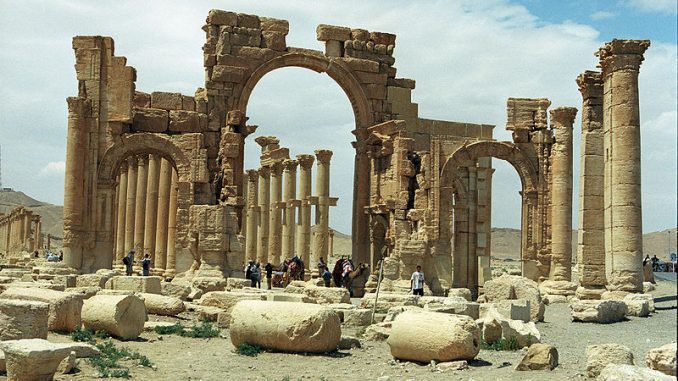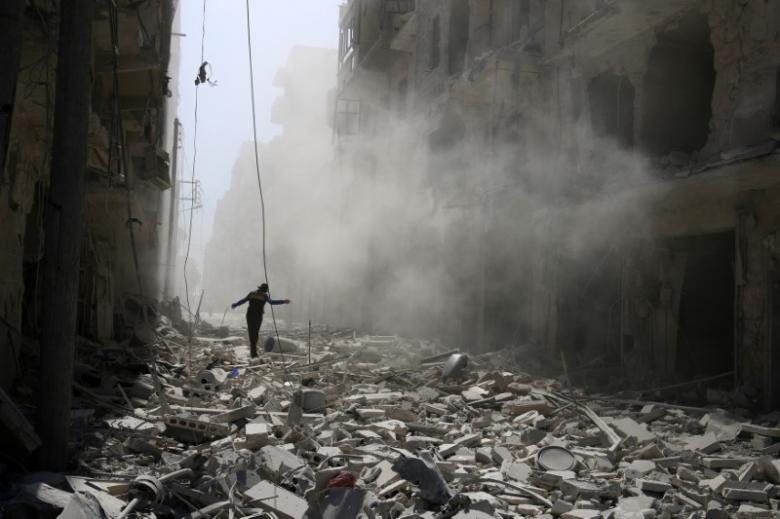
Islamic State militants have mass executed 12 people in Palmyra city that fell in its hands recently, as its campaign on Deir Ezzor is getting more fierce.
Monitors said teachers were among 12 people murdered in front of crowds of men and children in th Syrian city of Palmyra. Four people were beheaded and eight other were shot dead.
The Palmyra Monitor group said captives were killed in three separate locations – Free Syrian Army and regime soldiers in two groups at the Roman theatre and in an abandoned Russian military base, and civilians outside Palmyra Museum. The civilians were four teachers and state employees.
“There are now fears that ISIS may carry out more executions of civilians who were arrested after it took control of the city,” the group said.
“There are about 75 Palmyrene civilians still under arrest by ISIS and dozens of regime soldiers and militia men.”
The UK-based Syrian Observatory of Human Rights said all the captives, including city employees and teachers, were beheaded on Wednesday.
ISIS favored Palmyra as a setting for its gory execution videos after first gaining control of the city in 2015, including footage showing the killing of 25 soldiers in its Roman theatre, formerly a famed tourist attraction.
Militants publicly beheaded the city’s 81-year-old head of antiquities, Khaled al-Assad, after he helped remove artifacts from the museum and refused to reveal the location of hidden treasures from the Unesco World Heritage Site.
ISIS retook the site and nearby city last month, after being pushed out in March with the help of Russian forces.
Deir Ezzor offensive
At the same time, ISIS continued its offensive on the regime-held areas of Deir Ezzor city.
ISIS took a large part of the city of Deir Ezzor in July 2014 and forced a crippling siege on the regime’s remaining areas since January 2015. Assad regime retained control of the airport and neighboring districts in the city, which lies on the Euphrates river.
The residents of Deir Ezzor and the Assad regime’s military forces receive food only via planes delivering humanitarian aid after all the roads have been cut by ISIS
ISIS has launched many offensives trying to capture the remaining regime’s enclave or at least cut it from the close military airport.
The last offensive started a few days ago and reached its peak point on last Monday.
Isis fighters, which sources from the city said were primarily reinforcements coming over the border from Iraq’s Anbar province, broke through government lines, splitting its territory in half and taking control of the area where the WFP’s airdrops landed.
A Syrian military source said the fighting was intense. “This attack is one of the most fierce attempts by ISIS on the airport and the area,” Reuters reported. “It seems ISIS has mobilized a big force.”
Describing the fighting as the fiercest in the eastern city for a year, the Syrian Observatory for Human Rights said on Monday that at least 82 people had been killed.
It also reported that Islamic State had cut the road linking the air base to the rest of the government enclave, meaning the army would be able to supply the city only by air drops.
The UN body announced on Monday that it had halted its airdrops, leaving a quarter of a million civilians under a tightened ISIS siege.
ISIS new strategy
While world attention has been on Aleppo and Damascus, ISIS has made renewed advances in the country’s east where its forces in Syria are concentrated.
Observers believe the aim of the Isis assault on Deir Ezzor is to preempt any Syrian government offensive on its territory while the group is distracted by battles elsewhere. The area under Isis control in the city has an estimated 10,000 civilians and is hemmed in by government forces to the south and the Euphrates river to the north.
Deir Ezzor has long had major strategic importance. It is close to key oilfields that were a crucial financial lifeline for Isis and is also near militant supply lines that were used to smuggle fighters across the nearby Iraqi border, even during the US occupation.
The fighting in Deir Ezzor shows Isis still has the capacity to launch major military operations despite the loss of much territory and tens of thousands of fighters on multiple battlefronts over the last two and a half years.
Last month ISIS recaptured the city of Palmyra, 185km southwest of Deir Ezzor, from the government in an unexpected advance that demonstrated its continuing military threat.
In addition, ISIS has blown up on January 9 the “Hayyan” Gas company in Hijaz region in the eastern countryside of Homs using tons of highly explosive material.
The company, that was taken over by ISIS last month after a fierce attack on the eastern countryside of Homs, produces about 3.5 million cubic meters of gas, about 6 thousand barrels per day, and 180 thousand tons of gas for household usage.
The company is considered Syria’s biggest gas supplier and started working in 2011 at a cost estimated at 290 million euros.
The regime’s hands in Deir Ezzor seem tied up as it can do nothing other than airstrikes on ISIS’s locations but no moves on the ground. Therefore, the regime seeks to achieve an alternative victory in Palmyra.
It was initially believed that the military operation in Palmyra against ISIS would not begin until February or even March. However, reports say that the regime forces are going to accelerate the timing of this assault in their attempt to retrieve natural resources from ISIS and to absorb the growing dissatisfaction of the civilians.
The Syrian crisis began as a peaceful demonstration against the injustice in Syria. Assad regime used to fire power and violence against the civilians and led to armed resistance. 450.000 Syrians lost their lives in the past five years according to UN estimates, and more than 12 million have lost their homes.



